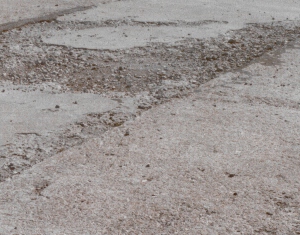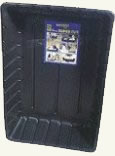
Figure 1 - Concrete slab spalling
Many homeowners look at their damaged concrete driveways, patios and walkways and believe that they must be replaced. However, this is not necessarily the case. Most concrete can be successfully resurfaced, saving countless dollars in expense, time, noise and the overall mess that removing a concrete structure will create.
Although epoxy has been with us for a number of years, formulations have been advanced and the use of epoxy with a small aggregate can now be poured on an old concrete surface to form a new extremely hard-wearing, surface which will fill cracks, potholes and other damage.
Unlike a traditional concrete pour that can take days and even weeks to total cure, the new concrete epoxy surface repair products cure in a day, sometimes less, which means that the concrete can be put back into service quickly.
Note: Some people may advise you, that you can make your own resurfacing product by mixing Portland cement with sand and water. The problem is that this fix will most likely not last very long, as concrete created in this manner is not designed for thin application, it needs the epoxy to hold it together while bonding with the old concrete.
If you are going to resurface your concrete you may wish to consider enhancing the finish using decorative concrete coloring, staining and stampings.
Additional information on:
Decorative concrete
Concrete staining
Cost:
If you have a concrete slab that is showing signs of scaling and may or may not have some cracks in it you will want to budget a cost. While costs vary in different geographic locations and the extent of the damage can vary dramatically, for budgeting purposes you can consider $3 a square foot, for a traditional concrete finish, if done by a contractor. The overall size of the project will also be a factor in the cost. A small job will cost a lot more per square foot than a large project. As with most projects there is a basic start-up cost of getting to the site. A job that may only take a contractor 4 hours will probably be priced as if the contractor was at your home for the entire day.
Decorative finishes can easily be priced around $8 a square foot, depending on the complexity.
If you are a reasonably adept home handyman, resurfacing a concrete slab is not an overly difficult project. Specialty tools are generally not required, a pressure washer, as shown in Figure 2, some basic concrete finishing tools and a concrete mixing tub, as shown in Figure 3 or wheelbarrow, as shown in Figure 4.

Figure 2 - Pressure washer

Figure 3 - Concrete mixing tub

Figure 4 - Wheelbarrow

Figure 5 - Mini sledge hammer

Figure 6 - Concrete float
Note: Always use safety goggles when using a power washer and mixing concrete.
Note: When performing a resurfacing, remember that the control joints that were placed in the concrete are there for a purpose and should not be covered with the resurfacing material. Placing a 1/2″ piece of lumber or plywood on its edge on top of the control joints will prevent the resurfacing material from filling those voids.
Concrete resurfacing steps:
- Clean off any and all debris from the concrete slab using a push broom and then the pressure washer, as shown in Figure 2.
- If the surface of the concrete slab is suffering from delamination in a few areas, it is wise to hit the top of the concrete surface with a 2 lb. to 5 lb. mini sledge hammer, as shown in Figure 5, to see if any more of the surface will breakaway. You want the surface of the old concrete to be stable before resurfacing.
- All dirt, grime, grease, oil and other contaminants must be washed off the surface of the concrete. Use a high quality concrete cleaner.
- Wet the concrete pad. Do not allow the water to pool or create puddles
- Place a wood frame around the old concrete so that the new surface material does not flow off the sides. Install the boards to protect the control joints from the resurfacing material.
- Mix the concrete resurfacing material in a wheelbarrow (Figure 4) or mixing tub (Figure 3). Follow the manufactures instructions as to the mix proportions of the concrete and epoxy additives.
- Place the mixed concrete resurfacing material over the old concrete starting at one corner.
- Use a masonry trowel to spread the concrete evenly over the surface of the old concrete slab. To smooth the surface use a concrete float, as shown in Figure 6, while the concrete is wet. For a non-slip surface you can run a corn broom over the surface of the wet concrete.
Remember that the concrete dries relatively quickly and depending on the size of your resurfacing project you may wish to consider doing it in sections.
Allow the concrete resurfacing material to dry for at least 8 hours before walking on it. To speed up the curing process you can cover the resurfacing material with plastic sheeting.
